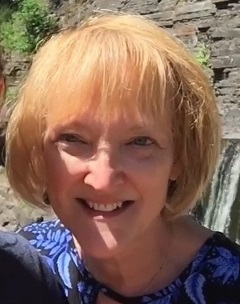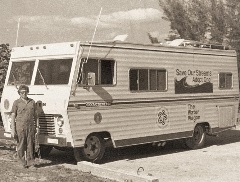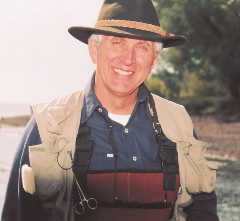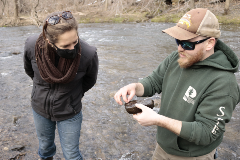As we remember the League’s 100-year history and early leaders, we also celebrate current members and volunteers who have helped shape the League and who continue its extraordinary legacy today. Throughout the year, we will ask some of these people to reflect on the League’s history, discuss the present and imagine our future.
In this issue, members Dave Whitney, Anita Stonebraker, Dave Zentner and volunteer Kevin Roth share insights. Their inspired service lays the groundwork for the next generation of conservation leaders.
 Anita Stonebraker visits Kaaterskill Falls in New York.
Anita Stonebraker visits Kaaterskill Falls in New York.
Anita Stonebraker
Owning property that adjoins the Lois Green-Sligo Chapter (LGS) in Gaithersburg, Md., it was not hard for Anita Stonebraker to find the nearest chapter of the Izaak Walton League. Coming from a hunting and fishing family, she was curious and found a warm welcome from the chapter.
The appeal of the members and the idea of land stewardship inspired Stonebraker to join—and stay for two decades. She also served as treasurer and is now president. Today she is proud of the chapter’s vibrant membership and growth, which she describes as “bursting at the seams.”
In a time when Americans are not joining organizations as much as they once did, Stonebraker has found that proactively welcoming and embracing non-members has helped the chapter to expand and succeed.
The chapter offers use of its property to Scout troops, the Youth Civil Air Patrol and other groups in the community. LGS is surrounded by residential neighborhoods, so Stonebraker and members reached out to dog walkers and local anglers to showcase the chapter’s resources.
Stonebraker has found that proactively welcoming and embracing non-members has helped the chapter to expand and succeed.
LGS also works to add membership value through members-only events such as conservation projects and by allowing only members to bow hunt on the 63-acre property.
The League’s Save Our Streams program has made a strong impression on Stonebraker, who views SOS as another hands-on way to engage the local community. Through SOS, the chapter provides the information and tools that inspire citizen scientists to make connections to local waterways and remain mindful of water quality and conservation in their everyday activities.
Reflecting on the League’s centennial year, Stonebraker feels humbled by the legacy of hard work and accomplishments achieved by members who have come before. Stonebraker cites the National Wildlife Refuge System Improvement Act and the Clean Air Act as a few of the legislative achievements that inspire her.
“As members and leaders, it is our responsibility to continue this heritage and keep moving toward a cleaner and more hospitable earth,” she said.
 Dave Whitney delivered the League's clean water message to legions of volunteers nationwide from this Coachmen RV dubbed the Water Wagon.
Dave Whitney delivered the League's clean water message to legions of volunteers nationwide from this Coachmen RV dubbed the Water Wagon.
Dave Whitney
In the mid-1970s, Dave Whitney spent nearly three years on the road delivering clean water messages to every state in the continental U.S. He drove what would now be described as a vintage Coachmen RV, dubbed “the Water Wagon.”
The idea was to take the message directly to the people instead of hoping that they would read a flyer delivered in their mailbox. As a League member and Save Our Streams (SOS) leader, Whitney believed he could enlist volunteers if only he could get them to the water to see the problems first-hand.
Logging 130,000 miles, Whitney brought the clean water message to tens of thousands of people through appearances at League chapters, schools and colleges—and with help from local, regional and national television stations that loved the visual as well as the environmental dimensions of the story.
His appearances attracted new members and established the League’s SOS program as the basic model for many of the water-focused citizen science programs today.
Whitney had been working for the Iowa Department of Environmental Protection in the mid-1970s when the Environmental Protection Agency invited him to Washington, DC to speak at a meeting about the Water Pollution Control Act of 1972. Jack Lorenz, League executive director from 1974 to 1992, was at that meeting and approached Whitney, eventually persuading him to join the League to improve and expand the SOS program.
Whitney believes that the big picture has not changed – nor should it. Protecting our natural resources is as relevant today, if not more so, than it was 100 years ago.
Whitney recalls, “I roughed out a program for Jack where the League would get a motor home and put the SOS program on the road.”
Proud to be a life member, Whitney believes that the big picture for the League has not changed – nor should it. Protecting our natural resources is as relevant today, if not more so, than it was 100 years ago.
Besides the need for ongoing water conservation and education, Whitney thinks the League must continue to work hard for funding. To fund his cross-country “Water Wagon” excursion, he constantly worked to raise money. He helped develop the Endowment’s Million Dollar Club, which takes $1,000 donations and invests them to provide for conservation grants funded by the earnings. He single-handedly raised $18,000 in donations during one conference.
“I learned the best way to raise money is to ask for it. And never take ‘no’ personally,” he declared.
Whitney applauds the League’s embrace of technology, like using smartphone photographs in stream monitoring. Of course, cell phones would have been useful in the 1970s when he was on the road for weeks at a time. “When Jack wanted to get me on the phone, he would call the highway patrol in whatever state I was in, have them stop me, and tell me to call the office,” he chuckled.
 Dave Zentner hopes the League's second century is even better than its first.
Dave Zentner hopes the League's second century is even better than its first.
Dave Zentner
A former Minnesota division president, national president and member of the National Endowment Board, Dave Zentner is a life-long member of the League. He cherishes many experiences and campaigns associated with his membership.
He puts creation of Voyageurs National Park in Minnesota at the top of his list. Owing to his work on that effort, he was presented with the League’s highest honor, the 54 Founders Award in 1992. Other experiences he had a hand in:
- Passage of the 1978 Boundary Waters Canoe Area legislation that expanded that wilderness area
- Stopping a mining company from dumping tailings waste into Lake Superior
- Passage of Minnesota’s Clean Water and Land Legacy amendment and
- Watershed restorations, including serving as the first project director for the Upper Mississippi River Initiative.
Proud of the League’s legacy, Zentner has fond memories of its many efforts such as promoting the North American model of wildlife conservation and the creation of state and national wildlife refuges. “Not to mention the passage of the Clean Water Act…the League has always insisted that the resources come first,” he said.He also mentioned multiple local projects that had noble outcomes, which included citizen science and outdoor ethical considerations.
The League's strength comes from its structure, the local chapters and grassroots science, says Zentner. He sees a future Izaak Walton League that includes more diversity in the leadership and membership.
Today he finds that the Ikes remain a respected institution, retaining solid examples of community problem-solving that lead to enlightened environmental public policy.
Zentner believes that the League’s major strength is its structure, local chapters and grassroots science. He is excited by its ability to connect to issues locally as well as at the state and national levels.
“Our history is admirable. That said, we need to create a new history,” he insists. He proposes a second century that is even better than the first – more connected, engaged and reimagined.
He’d like to see a re-creation of the magic that is essential in any successful organization: a membership base that feels as if they are part of a difference-making mission. To him that means an adaptation in the League’s programming to ensure that it is positively influencing the big issues of the 21st century.
He feels that the goal of conservation as part of everyone’s life is still valid, and he sees a future Izaak Walton League that includes more diversity in the leadership and membership.
 Erin Landis and Kevin Roth examine caddisfly larvae during Save Our Streams training.
Erin Landis and Kevin Roth examine caddisfly larvae during Save Our Streams training.
Kevin Roth
In 2018, volunteer Kevin Roth’s hometown was hit hard by a surprise snowstorm. Within 24 hours, the dissolved salts in one of his locally monitored creeks had tripled and the creek went from fresh water to slightly brackish within six hours.
He joined forces with the Izaak Walton League and signed up with the Salt Watch program to begin educating the community about salt use and tracking chloride levels in the area’s streams and creeks.
Roth coordinates education, outreach and volunteers for the Pennypack Ecological Restoration Trust in Huntingdon Valley, Pa., one of the League’s vital partners for Salt Watch and stream monitoring. The League provided the training and equipment he needed to educate the public about winter salt use and the importance of macroinvertebrate populations in local creeks.
During the spring of 2021, the Trust participated in the SOS program by certifying its own Streamkeepers (Trust citizen scientists who conduct water quality monitoring efforts). With the League’s help, Trust members and volunteers were able to create a database of macroinvertebrate populations, compare that data with historical data and eventually host public presentations to share the findings.
Volunteers allow the Trust to monitor larger stretches of creek and identify problems before they worsen.
“Thanks to the SOS program, we have several volunteers certified in macroinvertebrate collection and identification,” Roth told Outdoor America. “These volunteers allow the Trust to monitor larger stretches of creek and identify problems before they worsen.”
Roth notes that the number of stream monitoring resources available to the public has increased, and the League’s offerings have expanded throughout the country. That growth has allowed organizations that don’t have enough staff or funding to reach more people.
He typically suggests that his volunteers start with the Salt Watch or SOS programs because it’s the easiest entry point for citizen scientists to get started. Once a volunteer learns how to become a better steward of the environment, they are more likely to incorporate practices into their daily lives and share them with family and friends.
Roth believes that it’s all about encouraging people to climb the “engagement ladder” of environmental awareness and conservation. Thanks to Roth and the League’s programs, more Pennsylvanians are stepping up and taking action for conservation and restoration.
The Izaak Walton League's first century of conservation success was carried forward by committed heroes working together to defend America's natural resources. During our centennial celebrations, we're sharing their stories. Look for more profiles of iconic Ikes throughout 2022.
Today could be the first day of your own story as an iconic Ike.
Join the Izaak Walton League
Rion Haley is a freelance writer, master gardener and former editor of Outdoor America.